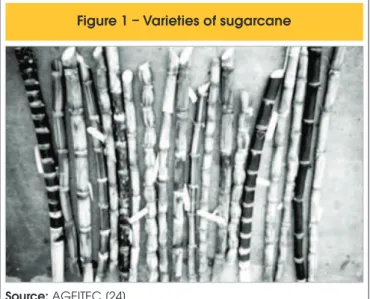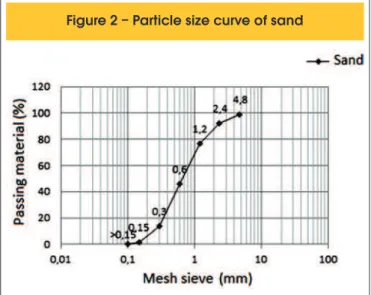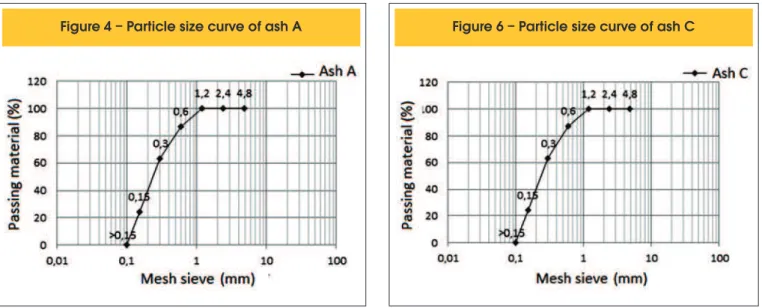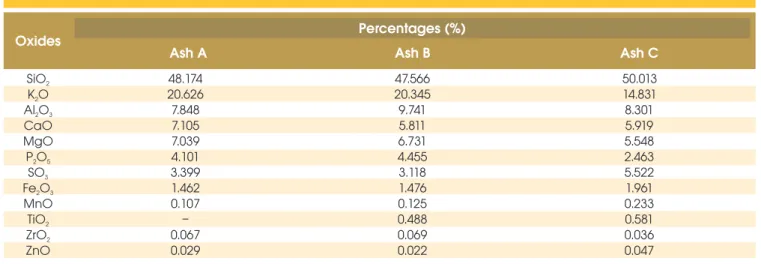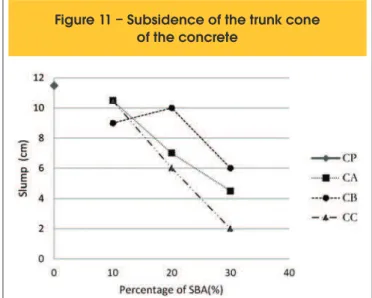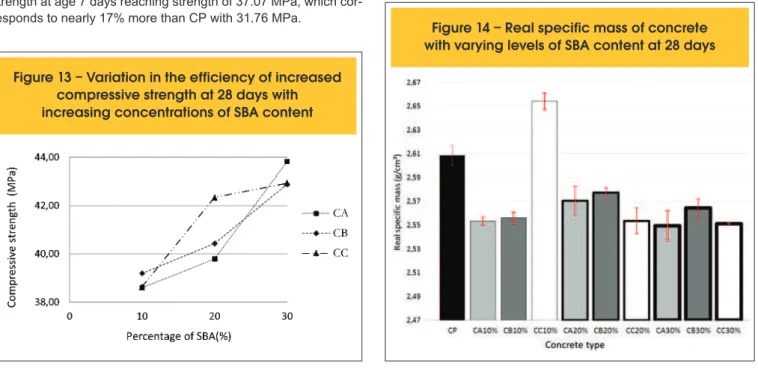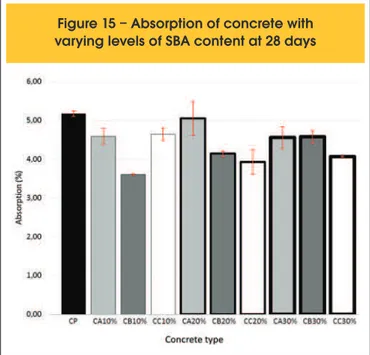Concrete is the second most consumed product in the world and the incorporation of agro-industrial waste to this material, such as Sugar Cane Bagasse Ash (SBA) , can provide solutions for the utilization of by-products from other industries, thus reducing the environmental impact. The main objective of this paper was to analyze the mechanical behavior of concrete containing SBA from three different species of cane sugar (SP911049, SP816949 and RB92579) by testing consistency,voids,absorption, porosity and compressive strength. Were produced 13 specimens of standard concrete and for each SBA content (10%, 20% and 30%) of the three varieties collected, totaling 130 samples of concrete. We em-ployed a mix proportion 1:2:3 (cement: sand: gravel) over the mass of cement with a water / cement ratio of 0.532 and 1% Tec Mult 400 Additive also based on the weight of cement. The results showed that the variety of cane sugar, used in the production the SBA, inluenced the mechanical behavior of the resulting concrete. All concrete with addition of SBA showed a reduction of at least 10% in the properties related to permeability and an increase in compressive strength of up to 20% compared to standard concrete after 28 days. The use of the SBA addition the concrete proved to be a very feasible option in improving the mechanical properties of concrete for use in normal constructions and also an appropriate destination to the agro-industrial by-product.
Keywords: concrete; bagasse ash from sugar cane; variety of sugar cane; sugarcane industry.
O concreto é o segundo produto mais consumido no mundo e a incorporação de resíduos agroindustriais, tais como a Cinza do Bagaço da Cana--de-açúcar (CBC), a este material pode apresentar soluções para o aproveitamento de subprodutos de outros setores, reduzindo assim o impacto ambiental. O objetivo principal deste trabalho foi de analisar o comportamento mecânico dos concretos contendo incorporações de CBC de três diferentes espécies de cana-de-açúcar (SP911049, RB92579 e SP816949), mediante ensaios de consistência, índice de vazios, absorção, po-rosidade total e resistência à compressão. Foram produzidos 13 corpos de prova para o concreto padrão e para cada teor de incorporação de CBC (10%, 20% e 30%) das três variedades coletadas, totalizando 130 amostras de concreto. Foi empregado o traço 1:2:3 (cimento:areia:brita) em relação à massa do cimento com um fator água/cimento de 0,532 e 1% de aditivo Tec Mult 400 também baseado na massa do cimento. Os resultados mostraram que a variedade da cana-de-açúcar, utilizada na produção das CBC, inluenciou no comportamento mecânico dos concretos resultantes. Todos os concretos com adição de CBC apresentaram uma redução de no mínimo 10% nas propriedades relacionadas à permeabilidade e um incremento na resistência à compressão de até 20% em relação ao concreto padrão aos 28 dias. O uso da CBC em adição ao concreto se mostrou uma opção bastante viável na melhoria das propriedades mecânicas do concreto para uso em construção civil em geral e também uma destinação adequada ao subproduto agro-industrial.
Palavras-chave: concretos; cinza do bagaço de cana-de-açúcar; variedade de cana-de-açúcar; indústria sucroalcooleira.
Analysis of the inluence of the sugar cane bagasse
ashes on mechanical behavior of concrete
Análise da inluência das cinzas do bagaço de
cana-de-açúcar no comportamento mecânico de concretos
Z. L. M. SAMPAIO a zodinio@hotmail.com
P. A. B. F. SOUZA a paulo.alysson@ig.com.br
B. G. GOUVEIA a dedeguida@hotmail.com
a Departamento de Engenharia Civil, UFRN, Natal, RN, Brasil.
Abstract
1. Introduction
In recent decades we noticed a gradual increase in disposal of different wastes in the environment, as well as problems arising from the shortage of natural raw materials in the civil construction business. These factors have encouraged the development of re-search in universities, academic centers, institutes and companies in search of speciic alternatives to the use of industrial waste as new materials in an attempt to reduce their environmental impact. The research aimed at providing the use of some byproducts, such as ground blast furnace slag and silica fume in concrete, turned this waste into commercially valuable materials. Especially for the eficient use of these residues as well as their combinations, which produce concrete with improved characteristics (NEVILLE, [1]). In the same vein, new economically viable mineral additions have been researched, in which there may be mentioned the rice husk ash (CCA) and sugarcane bagasse ash (SBA), among others (PRUDÊNCIO JR. ET AL. [2]).
During the production of sugar and alcohol, sugarcane bagasse resulting from the extraction of juice from sugarcane by milling pro-cess is generated as a byproduct. Bagasse has been harnessed as an energy source, because about 95% of this biomass is burned in boilers for steam generation in sugar and ethanol production, and generating a new residue, which is SBA (PAULA, ET AL. [3]). According to FIESP/CIESP [4], for every 250 kg of burnt bagasse there is a production of about 6 kg of residual ash (0.7% of sug-arcane weight). Normally, these ashes are used as fertilizers (ma-nure) in their own sugarcane cultivation, however, due to the lack of nutrients, they are often discarded in nature without an appropri-ate destination (CORDEIRO [5]).
The ash has as main chemical silica (SO2), typically in amounts up to 60% in mass (CORDEIRO [5]). By controlling the iring condi -tions, it is possible to keep the silica contained in the bagasse in an amorphous state, which is the main feature that enables the use of this waste as pozzolana. The high silicon (Si) content in SBA is absorbed from the soil by the roots of sugarcane in the form of monosilicic acid (H4SiO4). Subsequently, transpiration of the plant (water outlet), the silicon is retained on the outer wall of the cells of the epidermis in the form of silica gel (BORJA [6]).
The main studies on the subject are focused on the CCA that usu-ally presents levels of silicate (SiO2) above 90% (JOHN ET AL.[7]), however, other studies have demonstrated that the SBA may have equal potential for using only requiring further study. The use of SBA residue could allow not only technical advantages, as well as social beneits related to the reduction of discharges of waste into the environment which, in a sense, encourages innovation in research that veriies the potential of these materials.
Paula et al. [3] showed in a study that SBA is a viable mineral ad-dition cement source, depending on silica characteristics. In the case of the abovementioned study, silica (SiO2) found in SBA (at levels of 84%), performed both in the amorphous phase and the crystalline phases of cristobalite and quartz. The mortars produced with higher SBA levels were more porous, with greater water ab-sorption and the pozzolanic activity indexes have conirmed SBA reactivity. The results of compression tests at 28 days showed the feasibility of replacing up to 20% of cement by this material without prejudice to its strength.
Martins and Machado [8] used SBA in substitution of the sand in the production of concrete and found maximum strength values
at 28 days with 20% of SBA replacement regarding the mass of cement.
Cordeiro et al. [9] studied the behavior of the SBA as a mineral mixture in conventional and high-performance concrete with a water/cement ratio of 0.60 and 0.35, respectively. Substitutions of 0%, 10%, 15% and 20% of cement by SBA were used. The con-crete with ash showed better performance in rheological tests and plastic viscosity was not signiicantly changed by the SBA. The concrete with SBA showed the best results in tests of permeability of chloride ion.
Nunes et al. [10] studied concretes with addition of SBA to replace Portland cement, in which there was replacement of up to 13% of cement by ash. They have obtained a large increase in the com-pressive strength, in which the highest value was indicated by the replacement of 7% of ash.
However, Santos [11] warns that even with the advantages men-tioned, which are derived from the use of pozzolanas with Portland cement, the use of the material also has some disadvantages. A good example is the requirement of the use of water-reducing ad-ditives due to the increase in water demand in the mixtures and the need for appropriate cure for the pozzolanic reaction occurs in its fullness, as in the case of ly ash. Furthermore, by replacing part of pozzolan cement, concrete shall have lower initial strength, due to the slower pozzolanic reactions.
In Brazil, the use of SBA in the concrete becomes extremely impor-tant, since the country is among the world’s largest producers of sugarcane with numerous varieties. According to MAPA [12], the projections for agribusiness in 2008/2009 to 2018/2019, the sug-arcane area planted in Brazil is expected to increase to 6.0 million hectares, also increasing the varieties of sugarcane (Figure 1) and the amount of waste.
This paper focuses on analyzing the mechanical behavior of con-crete with the SBA addition of three distinct varieties of sugarcane in Portland cement. Therefore, real speciic and single mass, X-ray luorescence (XRF), X-X-ray diffraction (XRD), granulometry and pozzolanic activity of the ashes tests were carried out. In concrete, the analysis was based on tests in consistency, voids content, ab-sorption, porosity and compressive strength at 7 and 28 days
Figure 1 – Varieties of sugarcane
2. Materials and experimental program
For this study, laboratory tests were made with concrete in the mix proportion 1:2:3 (cement:sand:gravel), for a water to cement ra-tio of 0.53 by adding, for the cement weight, one percent (1%) of superplasticizer additive TecMult 400. It is worth noting that we used the abovementioned ratio because it is a trait widely used in construction because it is simple to implement and provides a concrete with good quality.
The type of cement used in concrete production of this research was the CP II Z 32 RS, originated from a single production batch. We adopted the cement in question, because it is a widely used type in the civil construction works in general. Then the standard-ized tests for Portland cement were performed, according to ABNT to analyze physical and chemical characteristics of the standard mortars, such as early handling, expansion, ineness, strength, speciic mass tests.
Aggregates (sand and gravel) were tested for speciic mass (NBR NM 52 [13] and NBR NM 53 [14]), unit mass (NBR NM 45 [15]) and particle size distribution (NBR NM 248 [16 ]). In the production of concrete, drinking water derived from public distribution by the Company for Water and Sewage of Rio Grande do Norte (CAERN) was used.
The additives are substances added to the concrete mixture tar-geting two main objectives: increasing the qualities of concrete and/or decreasing their weaknesses. The superplasticizer TecMult 400 was used, dark brown, pH 7.5 +/- 1.0 and speciic mass 1.205
± 0.02 g/cm3, in order to keep the suitable workability of concrete. SBA of species SP911049, RB92579 and SP816949 from the municipality of Pureza – Rio Grande do Norte (coordinates 217488.237 E, 9,392,890.759 N - AREA 25, according to DATUM SIRGAS 2000). It is important to highlight that abbreviations before the reference numbers of varieties of SBA refer to the place of origin in the case SP – “São Paulo” and RB – “Republic of Brazil”. For purposes of feasibility, in this work we chose to use SBA in the most natural way, i.e., with less treatment as possible in order to allow its use in large-scale.
SBA were collected randomly at the dump place of the boiler, after iring at 900 °C sugarcane bagasse and stored separately in plastic buckets. The agro-industrial characteristics of the collected variet-ies can be viewed in Table 1. The samples underwent a supericial observation, to verify color and uniformity, however, no substantial differences were observed with respect to these characteristics. Furthermore, a prior sieving with a sieve of mesh (#) 1.2 mm was done, to obtain uniform particles and eliminate possible impurities. Next, they were deposited in an oven for three days, with a temper-ature of 105 ºC, in order to eliminate their moisture. Subsequently, particle size (NBR NM 248 [16]), real speciic mass (NBR NM 52 [13]), unit speciic mass (NBR NM 45 [15]) and pozzolanicity with Portland cement were performed (NBR 5752 [17]). Importantly, CP II E 32 cement was used in the test for pozzolanic activity, since the standard does not allow the use of cements containing pozzolana
in their constitution. In addition, tests of X-ray luorescence (FRX) and X-ray diffraction (DRX) were performed.
Table 1 – Range of sugarcane and their agro-industrial features used in work
Range Parentals Agro-industrial features
Source: Association of Sugarcane Suppliers of Guariba (2012)
SP 911049
SP816949 RB92579
SP80-3328 X SP 701143
– RB75126
X RB72199
• Earliness and high sucrose content, being recommended for the beginning of harvest; • More productive than RB72454 in harsh production environments;
• Semi upright habit with average fiber content; • It flowers a little, but dries out;
• Resistant to major diseases and pests, considered as intermediate susceptibility to coal and leafhopper.
• Good sprouting with late maturing;
• Good yield of mechanical harvesting and transporting;
• Good sprouting of ratoons, but it has some restraint, it is liable to some fungal diseases and it does not require the best soils.
• Excellent agricultural productivity, good tillering, good closing of the row, great sprouting of ratoons, ensuring longevity of sugarcane plantations;
• Semi erect, with great harvestability; • Good recovery after drought;
• Responsive to irrigation and very efficient in water use; • Efficiency in the use of major nutrients;
• Great sucrose content, average maturity, recommended for collection from the middle to the end of harvest;
• Low flowering;
• Tolerant regarding the attack of common wireworm, resistant to brown rust and leaf scald and moderately resistant to soot;
In the production of concrete SBA with contents of 10, 20 and 30% regarding the weight of the cement for each variety were added to the Portland cement. The ratio used was based on previous tests and the studies of some authors who investigated the SBA (Paula et al., [3]; Martins e Machado [8]; Cordeiro et al., [9]). The mix pro-portion used in the production of concrete are shown in Table 2. The mixture was carried out through a mixer with inclined shaft with a nominal capacity of 120 liters and the sequence of introduction of the materials in the mixer followed the order:
a) With the mixer turned on, half of the kneading water was put up previously with the additive; b) All the amount of gravel was put up; c) The cement was added (In the production of concrete containing SBA, they were premixed with cement); d) The sand was placed; e) The remaining water was added; f) After all materials are placed in the mixer, this remained in motion for 5 minutes; g) the fresh concrete was discharged directly into the wheelbarrow, previously lubricated with water, so it does not absorb kneading water; In fresh concrete only the slump test was carried out according to NBR NM 67 [18].
In order to meet the tests a total of 13 cylindrical sample parts of 10 cm in diameter and 20 cm in height for each addition of SBA and the standard concrete were made, totaling 130 samples. With six for testing the compressive strength at 7 and 28 days, 3 for absorp-tion by immersion, voids, porosity and real speciic mass tests. The 4 remaining specimens were considered as extras.
After 24 hours at rest the samples were dismantled and subjected to curing process by immersion (NBR 5738 [19]) from 7 to 28 days, due to the type of test. After 28 days of moist curing, testing for ab-sorption by immersion, voids, porosity and speciic mass were per -formed according to NBR 9778 [20] for each dash manufactured. The compressive strength test was performed at 7 and 28 days, according to the prescription of standard NBR 5739 [21].
Speci-mens previously undergone a process of capping with sulfur in order to regulate the loading surface of the samples and ensure greater reliability in the test results.
3. Results and discussions
3.1 Cement
The ineness of the cement was found to be 2.6% and with water cement factor of 0.338 a paste of normal consistency was ob-tained, within the parameters prescribed by the standard. The
Table 2 – Concrete formulation
Concrete
Caption Type
of SBA Mix proportion of concrete of concrete (Kg)Mix proportion Mix proportion of concrete (L) cement ratio Water to content (%)Additive content (%)SBA
CP CA10% CA20% CA30% CB10% CB20% CB30% CC10% CC20% CC30%
CP – Standard Concrete with 0% of ash CA10% – Concrete with 10% of ash A CA20% – Concrete with 20% of ash A CB10% – Concrete with 10% of ash B CA30% – Concrete with 30% of ash A
CB20% – Concrete with 20% of ash B CB30% – Concrete with 30% of ash B CC10% – Concrete with 10% of ash C CC20% – Concrete with 20% of ash C CC30% – Concrete with 30% of ash C – SP 911049 SP 911049 SP 911049 RB 92579 RB 92579 RB 92579 SP 816949 SP 816949 SP 816949 1:2:3 1:2:3 1:2:3 1:2:3 1:2:3 1:2:3 1:2:3 1:2:3 1:2:3 1:2:3 8:16:24 8:16:24 8:16:24 8:16:24 8:16:24 8:16:24 8:16:24 8:16:24 8:16:24 8:16:24 2.71:6.15:8.9 2.71:6.15:8.9 2.71:6.15:8.9 2.71:6.15:8.9 2.71:6.15:8.9 2.71:6.15:8.9 2.71:6.15:8.9 2.71:6.15:8.9 2.71:6.15:8.9 2.71:6.15:8.9 0.53 0.53 0.53 0.53 0.53 0.53 0.53 0.53 0.53 0.53 1 1 1 1 1 1 1 1 1 1 0 10 20 30 10 20 30 10 20 30 Approximated total volume of concrete by mix proportion 22,1 Liters
setting process started two hours after the beginning of the test, the expansion was 1 mm and the strength at 28 days was 33 MPa. The values obtained in the characterization of cement met the speciications of standards for Portland cement type CP II 32 Z RS.
3.2 Aggregates
According to the particle size distribution shown in Figure 2 a ineness modulus of 2.71 and a maximum diameter of 4.8 mm were obtained and classiied this as medium sand. The real speciic and unit mass found was 2.61 kg/dm3 and 1.46 kg/dm3 respectively.
With the particle size distribution of Figure 3, it was possible to classify the gravel as 19 mm with a ineness modulus of 6.73. The speciic mass was 2.71 kg/dm3 and the unit was 1.55 kg/dm3. Importantly, the results obtained from tests for characterization of aggregates complied fully with the standards and are considered satisfactory for the production of good quality concrete.
3.3 Ashes of bagasse from sugarcane (SBA)
The granulometric composition of the ash proved very similar to each other, as shown by Figures 4, 5 and 6. However, the ash B showed ineness modulus 8% lower in comparison with other va -rieties. All of them had a maximum diameter of 1.2 mm, as shown in Table 3.
In grading curve a certain discontinuity for all varieties of ash was noticed, this fact may have been the result of incomplete combus-tion of bagasse. However, it was observed that in a comprehen-sive manner the ashes used in this study had very similar ine particle sizes.
3.4 Real speciic mass and unit mass of SBA
The results presented in Table 3 show that although the ash B has presented a slightly higher real speciic mass than ash C, the unit mass of this last one was lower compared to the others; therefore, it is lighter. The ash B showed a real speciic mass approximately
Figure 3 – Particle size curve of gravel
Figure 4 – Particle size curve of ash A
Figure
5 – Particle size curve of ash B
5% higher than the ash A and C and a unit mass 13% higher than C and 29% higher than ash A.
Similar values in the table were found by Lima et al. [22] in their studies with SBA.
3.5 X-ray luorescence of the SBA
According to Table 4, it is noted that SiO2 is the predominant com-pound of ashes, with levels of about 50% of the mass of the sam-ple, followed by K2O with contents in the range of 20%. The oxides Al2O3, CaO, MgO, P2O5 , SO3 and Fe2O3 represent about 30% of the ashes. Impurities still were observed as ZnO, MnO and ZrO2 with levels below 1%. It is noteworthy that the chemical composi-tion of bagasse ash can vary depending on the type of sugarcane cultivation, fertilizers and herbicides, and natural factors such as climate, soil and water (CORDEIRO [5]).
The percentage of silica, obtained in the test in question was below of those found in the literature (BORJA, et al. [6]). This fact can be explained by the harvest method of sugarcane. The company responsible for the SBA says that the manual method is used, which decreases by about 20% the amount of sand (SiO2) mixed with sugarcane. Above average levels of potassium oxide in all varieties were found, this fact may have been caused by the use of potash fertilizers. The other major oxides Al2O3 and CaO were within the range found in the literature (MARTINS, C. H.; MACHADO, P H. T. [8]; CORDEIRO, ET AL. [9]; NUNES, I.H.S. ET AL. [10]).
3.6 X-ray diffraction of the SBA
The XRD test results of the three varieties of sugarcane are shown in Figures 7, 8 e 9.
The results of chemical analysis by XRD presented in these Fig -ures show several silica peaks in the form of quartz and cristo-balite. The potassium aluminate silica was also observed in the form of microclimate, for all varieties of ashes, which agrees with the results obtained in XRF.
Table 3 – Particle size characteristics and specific masses of ash varieties
Ash A Ash B Ash C
Maximum diameter (mm) Fineness modulus Unit mass (kg/dm³) Real specific mass (kg/dm³)
1.2 1.25 0.75 2.30
1.2 1.15 0.85 2.42
1.2 1.26 0.66 2.33
Table 4 – Chemical composition of SBA by XRF (equivalent oxide)
Oxides Percentages (%)
SiO2 K O2 Al O2 3 CaO MgO P O2 5
SO3 Fe O2 3 MnO TiO2 ZrO2 ZnO
Ash A Ash B Ash C
48.174 20.626 7.848 7.105 7.039 4.101 3.399 1.462 0.107 – 0.067 0.029
47.566 20.345 9.741 5.811 6.731 4.455 3.118 1.476 0.125 0.488 0.069 0.022
50.013 14.831 8.301 5.919 5.548 2.463 5.522 1.961 0.233 0.581 0.036 0.047
The halo at 2θ = 6:18° characterizes the amorphous phase of the
SBA. However, the graphs obtained from this essay demonstrated that the SBA had a low reactivity due to the large amount of crystal-linity peaks found in the charts. However, it is possible to observe that the ash B showed peaks of crystallinity of lower intensities if compared to the other samples. Based on the results of XRD and burning ashes temperature, it can be stated that the burning was ineffective, which resulted in a very crystalline material, i.e., slightly reactive. This suggests that the inluence of the addition of SBA in concrete at different ages may be related to its lower ineness compared to sand.
3.7 Pozzolanicity of SBA
The NBR 5752 [17] standard provides that, for a material to be considered as a pozzolanic one, the compressive strength of mor-tars made with the material partially in replacement to Portland (PZ-free) cement shall be at least 75% of the strength of standard mortar. According to the results in Figure 10, it was concluded that the ashes analyzed in this study do not meet the requirements of pozzolanic standard, since the values have not reached the mini-mum that would be 24.03 MPa. The reduced pozzolanic activity of the ash can be attributed to the incomplete combustion of sugar-cane bagasse, resulting in a large amount of carbon. DRX results showed a large amount of crystalline silica (SiO2) in the form of quartz, a fact which has a direct action on the low rates of pozzola-nic activity found in the essay previously mentioned.
4. Concrete
4.1 Consistency
Changes in plastic behavior of concrete are shown in Figure 11, which allows concluding that there was a decrease in the work-ability of concrete with the increase of SBA content concentration. The workability of the concrete CA had an abnormal behavior with the addition of 20% of SBA, in which there was a slight increase. How-ever, the workability decreased again with the increase of SBA tent, becoming 55.5% lower than that presented by the standard con-crete (CP). Both CB and CC concon-crete showed a reduction of nearly 10% of workability compared to standard concrete with the addition of SBA in 10%. However, with the increase in the concentration of SBA
Figure 8 – DRX ash B
Figure 9 – DRX ash C
Figure 10 – Pozzolanic activity with Portland cement
of the concrete
contents, CC concrete lost more workability and at 30% of incorpora-tion was 475% lower than CP, while CB was 155% lower.
The sharp decrease in workability is justiied by the fact that the SBA, for being a residue with a very ine grain size, absorbs enough water needed to maintain the consistency of the concrete, leaving this drier and, consequently, less workable. Nevertheless, the val-ues still it the acceptable range for the standard NBR 6118 [23].
4.2 Compressive strength
The specimens related to compressive strength test were severed at 7 and 28 days and the results are shown in Figure 12. The val-ues shown in Figure are clear, concrete CA30%, although it has not shown a large increase in strength to 7 days, at 28 days showed a better performance compared to the others, reaching a compres-sive strength of 43.82 MPa, about 20% higher than the CP. The concrete CC20% proved to be very eficient in increasing the strength at age 7 days reaching strength of 37.07 MPa, which cor-responds to nearly 17% more than CP with 31.76 MPa.
The results also showed that almost all concrete with addition of SBA exceeded the strength of the CP at 7 days, with the exception of CA10% and CA20%, which showed a strength a little below the CP. These strengths may have been relected in a slow hydration of the constituents of SBA with Portland cement.
However, there was an improvement in these strengths at 28 days, exceeding the values of CP (36.56 MPa) with more than 5% (38.6 MPa and 39.79 respectively).
After 28 days, we observed that all material with SBA showed much more effective in terms of strength, if compared to CP with an edge at least 5%, reaching a maximum value of 20%.
By Figure 13, it is possible to verify that the strength of concrete containing SBA was increasing so that the contents of the addi-tions were growing. The concrete with ash “A” (CA), although it has been shown to be little eficient with 10% of addition (CA10%), as mentioned before, was gaining strength with increasing levels of addition contents, even surpassing all the others with 30% of addi-tion (CA30%). Although one can see in Figure that CB and CC had almost the same strength with 10% of addition and 30% of addition (CB10% and CC30%), however, there was a signiicant difference with 20% of addition (CB20% e CC20%).
The increase in strength with the addition of the SBA can be ex-plained by “iller effect”, as several bibliographies have shown (BORJA, ET AL.; CORDEIRO, G. C. [5]) and the results obtained by using the particle size of the ash corroborate this statement, since a large amount of ine particles was observed.
4.3 Real speciic mass test
According to Figure 14, the addition of SBA caused an almost neg-ligible variation in terms of real speciic mass of the concrete.
4.4 Absorption, void index and total porosity
The charts set out in Figures 15, 16 and 17 have demonstrated a
Figure 12 – Compressive strength during 7 and 28 days
of concrete with different levels of SBA content
Figure 1
3 – Variation in the efficiency of increased
compressive strength at 28 days with
increasing concentrations of SBA content
reduction in void index, absorption and total porosity in relation to the CP for all levels of SBA addition.
The concrete CA10% showed a decrease of approximately 13% of the voids with respect to CP. But with increasing addi-tion, there was a slight increase in the CA20%. On the other hand, void index decreased further in CA30%, approaching the value of CA10%. The concrete CB10% had a greater reduction in absorption, reaching to 43% less than the CP. However, this difference was being reduced with increasing levels of SBA closing with 13% of difference in CB30%. The amount of po-rosity in concrete CC10% was 11% lower than the CP and this difference was increasing with increased levels of SBA which
was close to be 26% smaller than the CP in concrete CC30%. The large reduction in porosity, absorption, and voids, resulting in an increase of compactness for all concretes containing SBA, can also be explained by the iller effect. This fact was expected, due to the increase in compressive strength previously presented. Table 6 shows all the results of the key properties that inluence the plastic and mechanical behavior of concrete with addition of SBA obtained in this work. In general, it can be stated that the ine grain of SBA increased wa -ter absorption in concrete. The incomplete combustion of burning at a temperature of 900 °C resulted in a decreased reactivity of the ashes, shown in pozzolanicity and DRX tests. The reduced diam -eter of SBA resulted in a illing of the pores of the cement matrix by the SBA grains. With the increased levels of incorporation and via the iller effect, a better compactness of the inal product was obtained, making the concrete more resistant.
5. Conclusions
The analyses performed in this study demonstrated that the in-corporation of the SBA in the concrete decreases the plasticity. This reduction is more signiicant with the increase of the levels of incorporation due to a higher amount of ines, which result in a higher water consumption.
The incorporation of the SBA in concrete increases the compres-sive strength of the iller effect and the increase of this strength is higher with increasing levels of addition of SBA. The concrete had a reduction of at least 10% of properties related to the permeability, and it was observed that keeping the levels of incorporation up to 30%, it is possible to increase the durability, because it decreases the total porosity, absorption, voids and increases strength. The varieties of SBA inluenced the workability and mechanical properties of concrete. There was a change in the consistency and in the strength, porosity, void index and absorption values by vary-ing SBA types. The use of SBA in addition to the concrete was shown as a very feasible option in improving the mechanical
prop-Figure 15 – Absorption of concrete with
varying levels of SBA content at 28 days
Figure 1
6 – Void index of concrete with
erties of the concrete and it can be used in pre-molded concrete, loors and civil works in general, besides providing a suitable des -tination to agro-industrial by-product.
6. Special thanks
Main thanks to the following people and institutions, because with-out them this work would have been impossible.
To (PEC-UFRN) Graduate Studies Program in Civil Engineering for their responsiveness, technical and administrative support; To the Graduate Studies Program in Science of Materials (PPG-CEM/CCET) for the availability of equipment;
To technicians Francisco A. Braz and Sandro Andrade R. S. for their ceaseless collaboration.
7. References
[01] NEVILLE, A. (1997) Propriedades do concreto. São Paulo: PINI. 1997.
[02] PRUDÊNCIO Jr., et al. (2003). Cinza da casca de arroz. In: Utilização de Residuos na Construção Habitacional, coleção Habitare, v.4, Porto Alegre: ANTAC
[03] PAULA, M. O. de; TINÔCO. I. F. F.; RODRIGUES, C. S.; SILVA, E. N. S.; SOUZA, C. F. (2009). Potencial da cinza do bagaço da cana-de-açúcar como material de substituição parcial de cimento Portland. Available in:
<http://www.scielo.br/pdf/rbeaa/v13n3/v13n03a19.pdf>. Accessed on 23 Oct. 2012.
[04] FIESP - Federação das Indústrias do Estado de São Paulo. Available in: <<http://www www.iesp.com.br/>> Accessed on 26 Aug. 2011.
[05] CORDEIRO, G. C. Utilização de cinzas ultrainas do bagaço de cana-de-açúcar e da casca de arroz como aditivos minerais em concreto. Tese (Doutorado). Universidade Federal do Rio de Janeiro, 2006.
[06] BORJA, Edilberto Vitorino de. (2011) Efeito da adição de ar-gila expandida e adições minerais na formulação de concre-tos estruturais leves autoadensáveis. Tese de Doutorado, 2011. Universidade Federal do Rio Grande do Norte. [07] JOHN, V. M.; Cincotto, M. A.; Silva, M. G. Cinza e
aglomer-antes alternativos. In: Freire, W. J.; Beraldo, A. L. Tecnolo-gia e materiais alternativos de construção. Campinas: UNI-CAMP, 2003. chap.6, p.145-190.
[08] MARTINS, C. H.; MACHADO, P H. T. Estudo da utilização da cinza do bagaço da cana-de-açucar em argamassas e concretos. In: ECMEC2010- Encontro Nacional de Materi-ais e Estruturas compósitas, 2010, Porto. AnMateri-ais do ECMEC 2010. Porto: Editora da Universidade do Porto.
[09] CORDEIRO, G. C.; TOLEDO FILHO, R. D.; FAIRBAIRN, E. M. R. Use of Ultra-Fine Sugar Cane Bagasse Ash as Mineral Admixture for Concrete. ACI Materials Journal, v. 105, n. 5, p. 487-493, 2008.
Table 5 – Compressive strength of mortars with ashes
Sample Strength (MPa) Coefficient of variation (%) Percentage in relation to A.P (%)
AP AA AB AC 32.04 16.13 15.15 13.96 5.56 8.26 6.33 3.58 – 5.34 47.28 43.57
CAPTION: AP – standard mortar; AA – mortar with ash A; AB – mortar with ash B; AC – mortar with ash C.
Table 6 – Results of the key properties that influence the mechanical
behavior of concrete with addition of SBA varieties
Concrete
type Subsidence (mm) Absorption (%) C.V (%) Voids index
(%) C.V
(%) C.V(%) C.V(%) C.V(%)
Total porosity (%) Real specific mass 3 (kg/dm ) Compressive strength at 28 days (MPa)
[10] NUNES, I.H.S.; VANDERLEI, R.D.; SECCHI, M.; ABE, M.A.P. Estudo das características físicas e químicas da cinza do bagaço de cana-de-açúcar para uso na construção. Revista Tecnológica, v. 17, p. 39-48, 2008.
[11] SANTOS, S. Produção e Avaliação do uso de pozolana com baixo teor de carbono obtida da cinza de casca de arroz residual para concreto de alto desempenho. Tese (Doutora-do). Universidade Federal de Santa Catarina, Florianópolis, 2006, 267p.
[12] MAPA. Available in: < http://www.unica.com.br/dadosCo-tacao/estatistica/>Accessed on 08 Aug. 2012.
[13] ASSOCIAÇÃO BRASILEIRA DE NORMAS TÉCNICAS. NBR NM 52: Agregado miúdo - Determinação da massa es-pecíica e massa eses-pecíica aparente. Rio de Janeiro, 2009. [14] ASSOCIAÇÃO BRASILEIRA DE NORMAS TÉCNICAS.
NBR NM 53: Agregado graúdo - Determinação da massa especíica, massa especíica aparente e absorção de água. Rio de Janeiro, 2009.
[15] ASSOCIAÇÃO BRASILEIRA DE NORMAS TÉCNICAS. NBR NM 45: Agregados - Determinação da massa unitária e do volume de vazios. Rio de Janeiro, 2006.
[16] ASSOCIAÇÃO BRASILEIRA DE NORMAS TÉCNICAS. NBR NM 248: Agregados - Determinação da composição granulométrica. Rio de Janeiro, 2003.
[17] ASSOCIAÇÃO BRASILEIRA DE NORMAS TÉCNICAS. NBR 5752:2012: Materiais pozolânicos - Determinação de atividade pozolânica com cimento Portland - Índice de ativi-dade pozolânica com cimento. Rio de Janeiro, 2012. [18] ASSOCIAÇÃO BRASILEIRA DE NORMAS TÉCNICAS.
NBR NM 67: Concreto - Determinação da consistência pelo abatimento do tronco de cone. Rio de Janeiro, 1998. [19] ASSOCIAÇÃO BRASILEIRA DE NORMAS TÉCNICAS.
NBR 5738: Concreto - Procedimento para moldagem e cura de corpos-de-prova. Rio de Janeiro, 2008.
[20] ASSOCIAÇÃO BRASILEIRA DE NORMAS TÉCNICAS. NBR 5739: Concreto - Ensaios de compressão de corpos-de-prova cilíndricos. Rio de Janeiro, 2007.
[21] ASSOCIAÇÃO BRASILEIRA DE NORMAS TÉCNICAS. NBR 9778: Argamassa e concreto endurecidos - Determina-ção da absorDetermina-ção de água, índice de vazios e massa especí-ica. Rio de Janeiro, 2009
[22] LIMA, S. A; SALES, A.; MORETTI, J. P.; ALMEIDA, F. C. R.; SANTOS, T. J. (2010). Caracterização de concretos confec-cionados com a cinza do bagaço da cana-de-açúcar. Tema Caracterização de Materiais. CINPAR 2010 – VI Congresso Internacional sobre patologia e reabilitação de estruturas. Córdoba, Argentina: 2, 3 e 4 de Jun. de 2010.
[23] ASSOCIAÇÃO BRASILEIRA DE NORMAS TÉCNICAS. NBR 6118: Projeto de estruturas de concreto – Procedimen-to. Rio de Janeiro, 2007.
